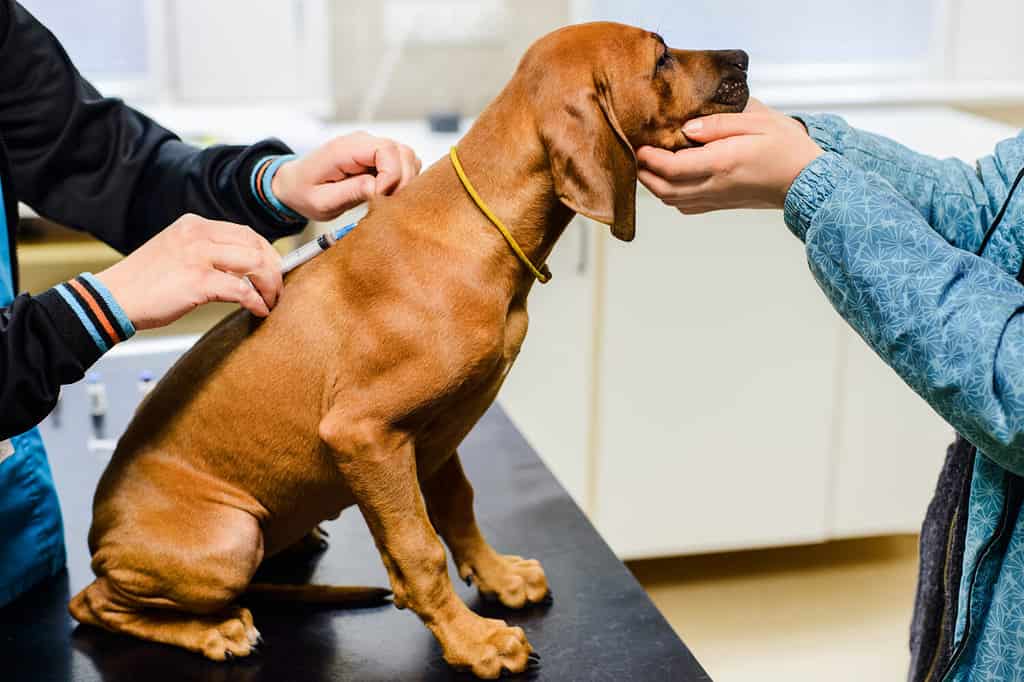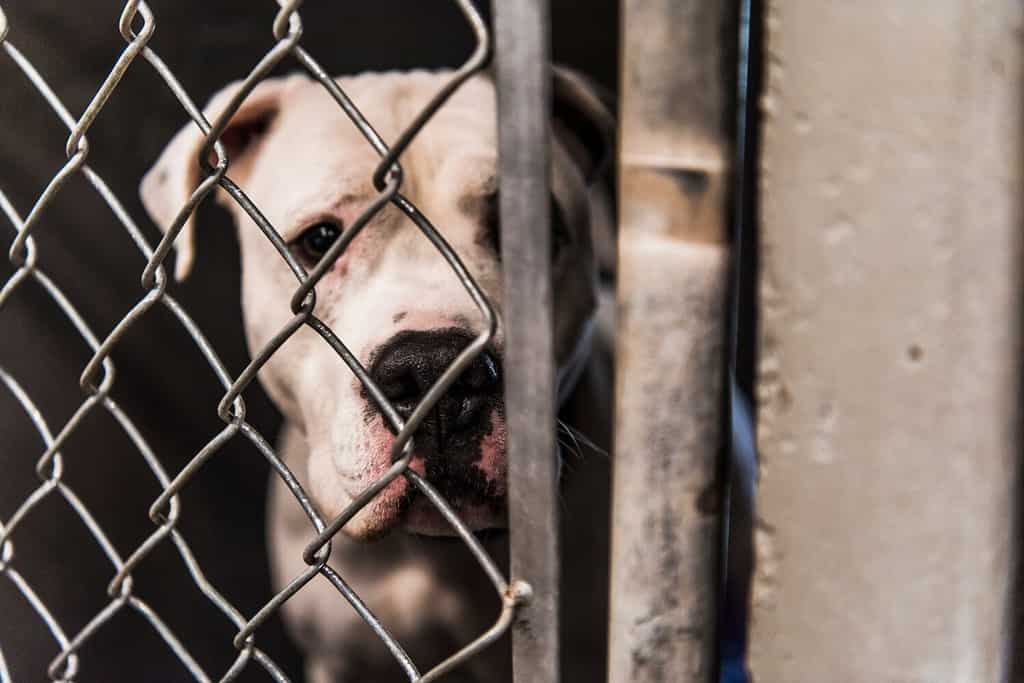What are the signs of rabies in dogs? If you have ever seen the 1957 Disney film, Old Yeller, or the 1983 classic, Cujo, you might feel pretty confident that you know exactly how to identify a rabid dog. Unfortunately, the signs of rabies in dogs can vary greatly. It can be difficult to determine whether dogs are showing early signs of rabies or if they are suffering from some other illness. Many of the signs of rabies are also indicators of other illnesses common to dogs. It is important to know what signs to look for because rabies can potentially kill anyone who is exposed to the saliva of an infected dog.
Clinical Signs of Rabies in Dogs
The clinical signs of rabies in dogs vary based on what parts of their brains are affected by the virus. Rabies causes acute encephalitis or inflammation of the brain. This inflammation can cause the dog to display a variety of abnormal behaviors and other signs. A dog infected with rabies may show any combination of the signs listed below. They can’t tell you what they are feeling, so you have to rely on visible signs of illness and changes in their normal behavior.
Abnormal Behavior

Normally active dogs may suddenly act shy, withdrawn, or lethargic. Calm dogs may be unusually aggressive.
©Korneeva Kristina/Shutterstock.com
In some cases, rabies may cause a dog to exhibit behavior that is unusual for them. This can include moderate to severe aggression toward other animals or humans, including unprovoked attacks, biting at inanimate objects or even the air, and other agitated behaviors. They may even bite and mutilate their own body. But rabies may cause an ordinarily active dog to become lethargic, withdrawn, shy, or scared. Some dogs with rabies have even been described as being overly clingy and exhibiting unusual affection.
Sensitivity to Light, Sound, and Touch

Dogs suffering from rabies may be extra sensitive to light, sound, or touch.
©iStock.com/APION
Dogs suffering from rabies may exhibit sensitivity to external stimuli, such as light, sound, and touch. Photophobia is the sensitivity to light. Dogs may try to retreat to dark places or get away from sounds. They may react aggressively to these stimuli, or to being touched in any way.
Refusal to Eat or Drink

Dogs suffering from rabies often refuse to eat or drink.
©Zontica/Shutterstock.com
Dogs with rabies often experience dysphagia, or difficulty swallowing. They may even refuse to eat or drink. Rabies causes damage to the cranial nerves which control the dog’s face and throat. Owners may think that their dog is in pain due to something caught in the back of their throat, or an injury from something they have swallowed.
Excessive Drooling

Excessive drooling or foaming at the mouth can be a sign of rabies.
©Wavetop/iStock via Getty Images
The same nerve damage can also cause excessive drooling, or foaming at the mouth, due to the inability to swallow properly. Many dogs that contract rabies eventually have excessive drooling or foam, beyond any drooling they might normally show. However, a lack of drool or foam cannot be taken as an indicator of the absence of rabies, however.
Gross Motor Difficulties
Another sign of rabies in dogs may be the appearance of gross motor difficulties. Dogs may have difficulty walking properly. They may appear to be disoriented or drunk, wobbly, walking with a leaning or sideways gait, or going in circles. They may even suffer from partial paralysis.
Altered Vocalization
If you own a dog, you most likely know its various vocalizations. You know how it barks when it wants to be fed, as opposed to how it barks when someone unfamiliar is at the door. A dog with rabies may vocalize in altered ways. Barks and yelps that sound strange to you, especially with no discernable reason behind them, may be signs of rabies.
Fever
Rabies can cause fever in dogs. They may have a low fever, a high fever, or no discernable change in temperature at all.
Seizures

Dogs in the end stages of rabies often have seizures.
©kamontad123/iStock via Getty Images
Dogs in the late stages of rabies may suffer from seizures. These seizures can include twitches and convulsions, but they can also present as temporary paralysis.
Timeline of Rabies Infection in Dogs
Rabies infection most often begins with a bite or scratch from an infected animal. The virus that causes rabies is passed through the saliva. Infection may also occur if an infected animal’s saliva contacts an open wound or a mucus membrane, such as the eyes.
Dog owners may think that their pet can’t possibly have rabies if they haven’t been bitten or scratched recently. Unfortunately, this is not the case. The incubation period, meaning the time between exposure to the virus to the time when signs or symptoms appear, can last anywhere from a few weeks to months. The virus must travel from the site of exposure to the brain before rabies sets in. The affected animal becomes infectious when the virus reaches the brain and shortly thereafter makes its way to the salivary glands.
Rabies can be prevented in dogs if they are treated quickly after exposure. Sadly, no treatment or cure exists for dogs once signs of rabies infection appear. By the time the clinical signs of rabies appear in a dog, death is imminent. Dogs usually die within about one week after signs of rabies become visible.
What to Do If You Suspect Rabies
Reaching out for help when your dog is showing signs of rabies can be a heartbreaking prospect. Just knowing that your dog will need to be euthanized if rabies is confirmed can be enough to make anyone a little hesitant to make that call. But continuing to care for a potentially rabid dog at home can have deadly consequences for you and your family.
If you suspect that your dog has rabies, confine it in a secure location and avoid any physical contact. Call your veterinarian or animal control immediately. Do not take your dog to a veterinary office or hospital without being instructed to do so. Your veterinarian will most likely want to examine your dog outside of office hours to minimize the risk of spreading rabies to other animals or humans.
What to Do in Case of Possible Rabies Exposure
In case of possible rabies exposure, you must act as quickly as you can to increase your dog’s chances of survival. You absolutely must be honest about your dog’s vaccination status and provide records if at all possible. According to the Centers for Disease Control and Prevention, the protocol for dealing with rabies exposure in dogs depends on whether the dog has been vaccinated, and how recently their last vaccine was administered. Accurate testing for rabies in dogs can only be done after the animal is euthanized, by examining its brain. However, euthanasia may not be necessary, depending on the dog’s vaccination status.
Dogs That Have Current Vaccinations

Keeping your dog up to date on their rabies vaccination is the best way to prevent the disease.
©olgagorovenko/Shutterstock.com
Dogs that are up-to-date on their rabies vaccine at the time of possible rabies exposure have the best chance of survival. The CDC recommends that they receive a rabies booster vaccine and quarantine at home for 45 days. If, during the quarantine period, they show signs of rabies, they must be euthanized. If they remain healthy throughout the 45 days, owners may presume they are in the clear.
Dogs Overdue for Vaccinations
Dogs that have had at least one rabies vaccination, but are overdue for their most recent booster, may also receive an immediate booster vaccine after possible rabies exposure. They should likewise quarantine at home for 45 days. If they show signs of rabies during the quarantine period, they must be euthanized.
Dogs Without Vaccinations

Dogs that have not been vaccinated prior to rabies exposure face euthanization.
©Hannah Carl/Shutterstock.com
Predictably, dogs that have never received a rabies vaccination have the highest risk of catching the disease. Upon exposure, the CDC recommends that these dogs should be euthanized immediately. If the owners refuse, they must quarantine for a minimum of four months. If the dogs show signs of rabies during the four-month quarantine period, they must be euthanized.
Preventing Rabies in Dogs
Owners in many countries can easily prevent rabies infections in dogs. Vaccinations are relatively inexpensive, and sometimes even offered for free at community clinics. Ideally, no one should choose to own a dog if they cannot address their basic health needs. Preventing a horrible virus that kills animals in a painful, torturous way is as simple as getting them a shot every one to three years.
World Rabies Day takes place on September 28. Communities in dozens of countries across the world will host free rabies vaccination clinics for dogs in an effort to stop the disease from spreading. You can make a difference, in your own community or in a nation across the globe. Spread awareness about the signs of rabies in dogs and do what you can to support organizations that promote rabies vaccination.
Thank you for reading! Have some feedback for us? Contact the AZ Animals editorial team.








